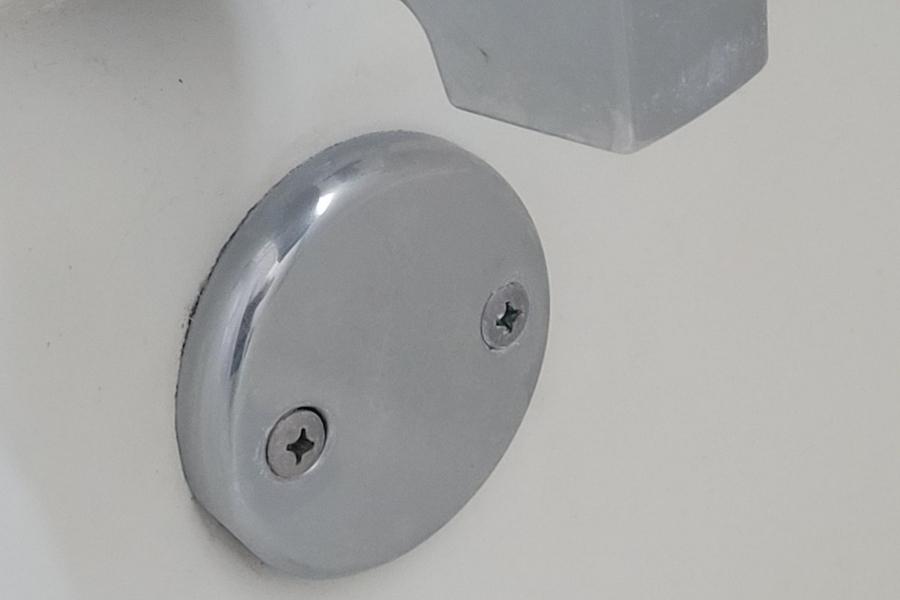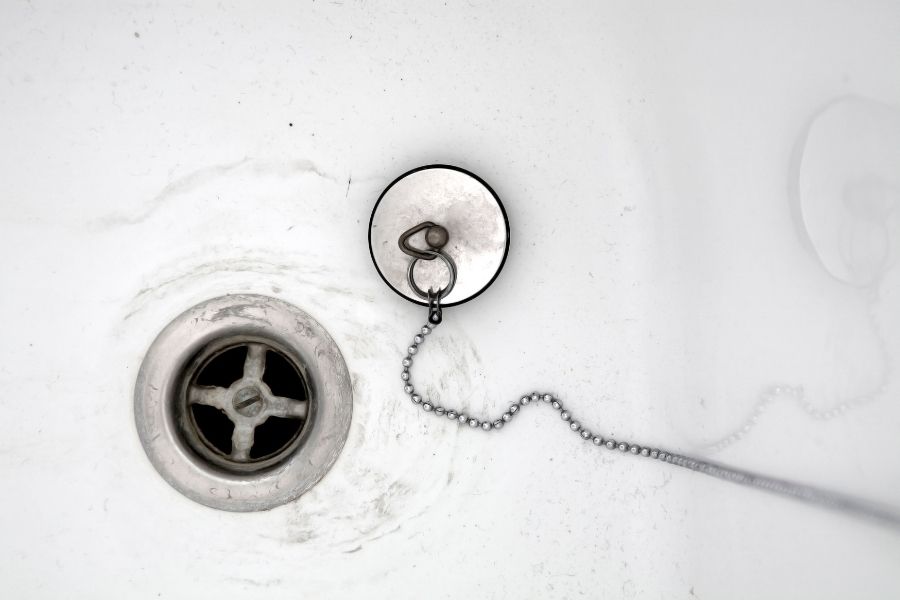Have a completely clogged drain in your bathtub? It’s a major issue and different from a tub that drains slowly.
It’s something you can’t leave unattended, which leaves homeowners scrambling for plungers or drain cleaners. A stopped up drain may also result in a costly repair bill in some cases.
Before you call the plumber, we’re going to tell you how to unclog a bathtub that has standing water.
Our tips will cover both natural and chemical methods that any homeowner can attempt themselves.
We’ve also included a few tricks to keep your plumbing clear and ensure stubborn bathtubs blockages become a thing of the past.
Check Bathtub Drain for Visible Blockages
While you may be in a hurry to get unclog a bathtub drain — check for blockages first. Whether you’ve given your child a bath or the family pet, you might be surprised by what’s clogging the drain.
With some types of tubs, the bathtub stopper could be the problem. The toe-touch or pop-up mechanism could be stuck, even though it appears to be okay. If the drain stopper isn’t the issue, you might be able to see or feel a visible blockage in the drain.
Small bath toys, pieces of sponges, and hair can become stuck around the cross-member in a drain flange.
Push-pull stoppers should unscrew in a counter-clockwise fashion, but other types of stoppers may have a set screw holding the top in place.
If you don’t feel a blockage or the water level doesn’t drop with its removal, it’s time to get a few supplies together.
Tools Required
What you need to unclog a bathtub drain depends on the method you choose. Below is a list of items you’ll need, including a few things you may already have in a cabinet.
A plumbing snake or auger is the exception, although something you can pick up from any hardware store.
- Baking Soda
- White vinegar
- Funnel
- Plunger
- Rag
- Rubber Gloves
- Drain Cleaner (optional)
- Plumber’s Snake (optional)
4 Ways to Unclog a Bathtub Drain With Standing Water
These methods should help to unclog most bathtub drains unless the blockage is severe. With that in mind, we will start with the safest and simplest methods for a tub before progressing to a more labor-intensive approach.
Method 1: Hot Water and Baking Soda
The easiest way to clear a blockage in a tub with standing water is to use baking soda, white vinegar, and a bit of hot water.
These are three things many homes already have, although you may need a funnel depending on the water depth.
Take 1/3 cup of baking soda and pour it into the drain, followed by a 1/3 cup of vinegar. You should hear or see a fizzy reaction begin to work.
The baking soda mixture will loosen any gunk and remove the clog if you’re lucky. You can also let this mixture sit for an hour and run warm water down the drain afterward to flush the pipes thoroughly.
Do not use boiling water and baking soda unless you have older cast iron or galvanized steel drain pipes in your home.
Method 2: Use a Plunger
When you have a bathtub with several inches of water or more, it’s usually time to break out the plunger. While it may seem simple, it’s not quite as easy as plunging a toilet because a bathtub has an overflow drain.

Before you can plunge the tub and unclog your bathtub drain, you’ll need to remove the overflow cover from the overflow opening and seal the hole tightly with a rag.
This helps to create a seal but the rag needs to be tight. The rag will move each time you plunge, so you may need a helper if you can’t plunge with one hand.
With the overflow hole covered, start plunging the drain as you would a commode with rapid thrusts. You’ll have no trouble getting a tight seal around the hole with the plunger, which may help remove the clog quickly.
Method 3: Drain Snakes
Despite the name, a drain snake is a plumbing tool – not a reptile that lives in bathtubs. Often called augers, a snake is designed to move blockages from drain pipes, whether those pipes are in the kitchen or a bathroom.
There are a variety of drain snakes, including electric ones, but we recommend choosing something simple like this handheld auger. To use these devices, you will need to remove the overflow plate for access to that area.
Using an auger is simple but can be messy, so be prepared to scrub the tub once the job is complete.
This video shows how to use a drain snake and what it might leave behind if you have a significant blockage in your bathtub.
Method 4: Chemical Drain Cleaners
One of the best ways to unclog a bathtub can also be the most harmful. Chemical drain cleaning can clear a tough clog in minutes, but some may cause issues with your plumbing.
The problem with these drain cleaners has to do with the condition of your plumbing and the type of cleaner used. Drain cleaners work by creating a chemical reaction that can dissolve or break up clogs in pipes.
These cleaners are powerful, but their acidic nature could cause older metal pipes to degrade. While a PVC pipe may seem safe, heat from some mixtures can potentially damage the pipe. With that in mind, there are several safe alternatives out there.
Cleaners like Green Gobbler are biodegradable, completely safe, and odorless. You won’t have to deal with fumes, although it might not be strong enough to clear a stubborn clog in a bathtub drain.
Something like Drano MAX Gel is better suited for these situations and safe for various types of pipes. When using drain cleaners of this nature, always read the directions carefully and follow them to the letter.
Most require the use of boiling water after a certain period of time, and it’s never a good idea to let chemical cleaners sit in a clogged tub drain.

Causes of a Clogged Bathtub Drain
Once you’ve cleared the drain in your bathtub, it’s a good idea to know how it got that way in the first place. This allows you to avoid clogs down the road or address any underlying issues with the plumbing system in your home.
Do people in your home have long hair? That will stop a bathtub up quickly over time, even if you brush before you get into the bathtub. The same applies to homeowners that bathe their pets in a bathtub.
You can help stop hair from going down the drain by purchasing a hair catcher for the shower in your home. These sit on top of the drain, and while they might impede water to a degree, they certainly catch loose hair.
Another reason drains clog is from soap scum, shampoos, oils, and other debris that get rinsed away every time someone gets in a bathtub and takes a shower.
Soap scum and shaving cream can slow things down, along with substances leftover from bath bombs.
Anything on someone’s body when they take a shower will go down the drain. Thankfully, this type of muck is relatively easy to break up with the methods mentioned in our guide.
When To Call a Plumber?
If you followed all of our steps and your tub still drains slowly or is stopped up, it’s time to call in a professional.
While you can attempt to repeat these steps, a plumber can use a large auger to clear even the most stubborn clogs. They can also tell you if the issue is hair and build up within a bathtub drain or something more severe.
A professional plumber will have your shower unclogged in less than an hour, although the cost varies by location and time spent on the job.
FAQ
Can I pour boiling water down a shower drain if there’s PVC plumbing in my home?
Professionals don’t recommend it, although it is something most of us have done and required with some chemical cleaners. When using boiling water, not “hot” water, it could melt or loosen joints between a PVC pipe.
Will hard water have an impact on how a bathtub drains?
Yes. Minerals in hard water can build up in your pipes, eventually leading to blockages and poor draining. Hair and other substances that go down the drain will hasten the process.
What’s the quickest way to unclog a tub drain with standing water?
If you have more than an inch or two of water, a plunger is usually the fastest way to clear a clog from a bathtub.
